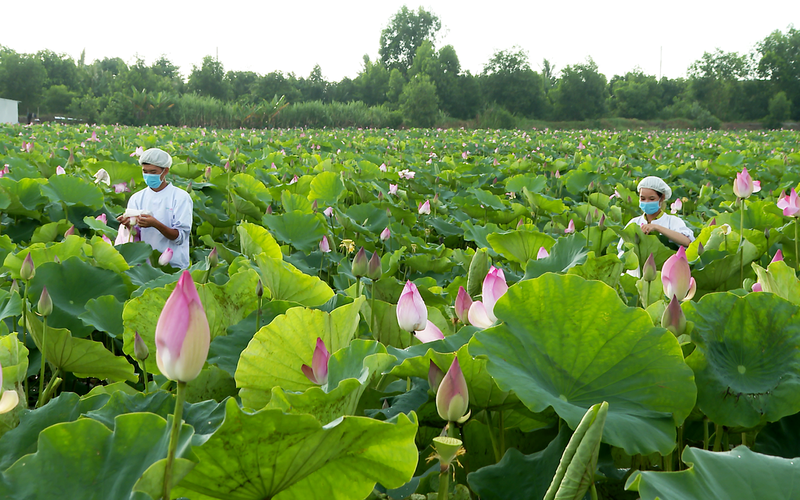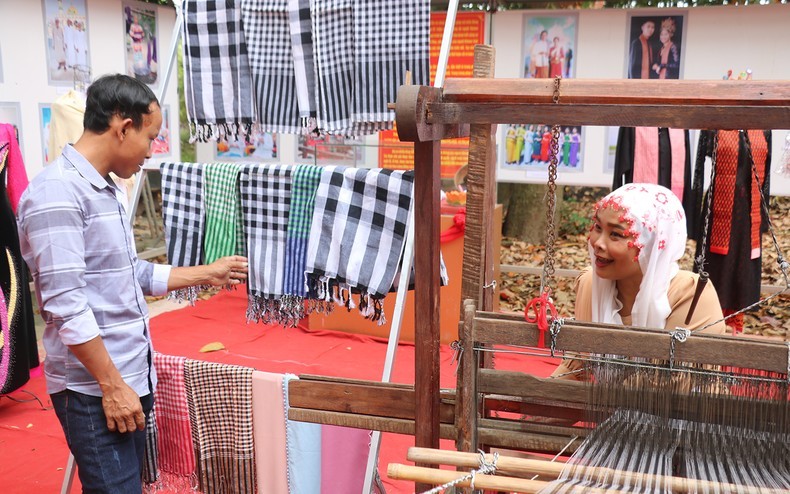Thanks to the enthusiastic participation of the entire political system and people in the implementation of the National Target Programme on building new-styled rural areas, the appearance of rural areas in the Southwest region has changed the area positively and the livelihoods of local people have been significantly improved.

Growing lotus has helped improve incomes for locals in Thap Muoi district, Dong Thap province
To realise the programme, provinces and cities in the region have set out priority tasks and solutions, including mobilising and integrating many resources to develop synchronous economic infrastructure, fostering urbanisation, and making the rural area a place worth living.
Chief of the An Giang provincial Coordination Office for building new-style rural area Nguyen Si Lam reported that Chau Doc and Long Xuyen cities, and Thoai Son district have met the standards to be considered new rural areas.
The whole province has 75 out of 116 communes meeting new rural standards. To date, the province has spent nearly 3 trillion VND to implement the national target programme on building new rural areas.
The province has launched an emulation movement to mobilise further social resources and public participation in implementing the programme, striving towards 100% of local communes meeting new rural standards by 2025.
Vo Thuy Y Nhu, Secretary of the Party Committee, Chairman of the People's Committee of Chau Phong commune in Tan Chau town, said that the commune was recognised as new-style rural area in October 2019. The commune has about 1,061 Cham ethnic households, accounting for 23.4% of the total population.
He hailed that the Cham ethnic people in the two hamlets of Phum Soai and Chau Giang have actively contributed to building new rural areas by donating money toward build bridges, upgrading roads, installing security cameras, and lighting up rural roads.
In addition, they have joined hands to clean up and plant trees to create a green, clean and beautiful living environment.
Cham households have also called on their family members to promote their ethnicity’s cultural traditions and observe the laws.
The annual per capita income of Chau Phong commune has increased from 51.4 million VND in 2019 to more than 60 million now.
Mohamad, owner of a brocade weaving establishment in Chau Phong commune, said he was glad about the improved transport network in the locality, creating favourable conditions to develop the Cham brocade weaving craft and tourism in general.
Visitors to the commune can explore the cultural beauty of the Cham ethnic people, learn more about the making of brocade weaving craft, and shop for brocade products. As a result, the business activities of brocade weaving establishments in the commune are becoming more vibrant, contributing to improving the income and living condition of locals.
Meanwhile Doc Binh Kieu Commune, Thap Muoi District, Dong Thap Province, achieved all 19 criteria of an advanced new rural area by the end of 2022.
Ho Thanh Tam, Secretary of the Party Committee, Chairman of the People's Committee of Doc Binh Kieu commune, added that the commune currently has 3,180 households with more than 12,000 people.
The locals show enthusiastic participation in the building of the new rural area by joining hands to improve transport infrastructure, accelerating agricultural restructuring, and developing the One Commune One Product programme.
Chairman of the People's Committee of Ngoc Bien commune, Tra Cu district, Tra Vinh province Tran Thi Hong Thuy said that more than 81% of households in the commune are Khmer ethnic people.
Previously, the poverty rate of the commune accounted for 21.55% with 485 households. Thanks to the effective implementation of the Party and State’s policies on ethnic groups as well as the programme on building new rural areas, the poverty rate has now dropped to less than 1%.
To date, the commune has mobilised more than 400 households to donate more than 144,000m2 of land, and hundreds of working days to the construction of irrigation projects, upgrading of rural roads, and sustainable poverty reduction.
The Vietnam Bank for Social Policies’ branch in Tra Cu district has granted loans worth more than 39.1 billion VND to early 1,700 households to help them develop the household economy. Thereby, the commune's per capita income reached more than 63.2 million VND in 2021, an increase of 35.7 million VND compared to 2015.

Visitors explore brocade weaving products made by locals in Tan Chau commune, An Giang province. (Photo: Minh Khoi)
Chairwoman of Chau Thanh District People's Committee Thi Sa Thy shared that in the period 2011-2021, the district mobilised nearly 3,000 billion VND for the building of new rural areas, 20% of which being donated by the locals.
The local economic structure has also witnessed a positive shift with the increase in the proportion of services and industry - construction sectors; per capita income is estimated at more than 52.4 million VND per year, an increase of 41.3 million VND as compared to 2011.
All of the 13 communes in the district have gained the new rural area title.
Following the success in deploying the new rural building in the 2010-2020 period, the Tra Vinh provincial People's Committee issued a plan to continue realising the plan for the 2021-2025 period withtotal funding of about 32.3 trillion VND. Of which, more than 398 billion VND was sourced from the State budget, over 597 billion VND from the provincial budget, and the rest was mobilised from businesses, people and the community.
The province aims to have 100% of communes meet new rural standards by 2023, complete the task of building new rural areas before 2025.
To fulfil this target, the province is focusing on mobilising resources from other relevant programmes and projects to support localities in building new rural areas while adopting favourable investment credit policies for agriculture and rural areas, and calingl on further contributions and participation from economic organisations, businesses, and locals to the work.
In its effort to promote the implementation of this programme, Dong Thap province prioritises on integrating the national target programme on building new rural areas with agricultural restructuring, sustainable poverty reduction and social security assurance while raising public awareness on this task.
The province is also working on building the “smart village” model; strengthening environmental protection, ensuring food safety, providing clean water in rural areas so that people there can get access the best environmental services and live in a safe and sustainable environment.